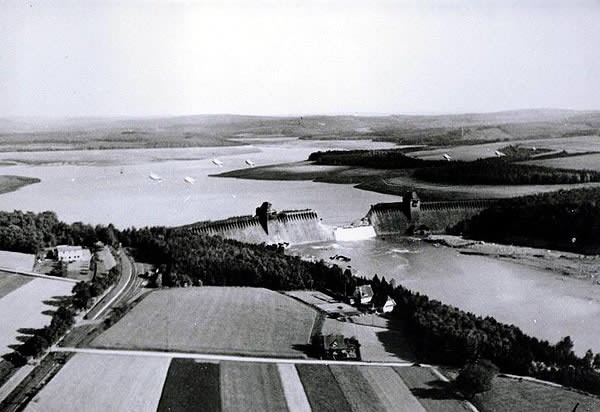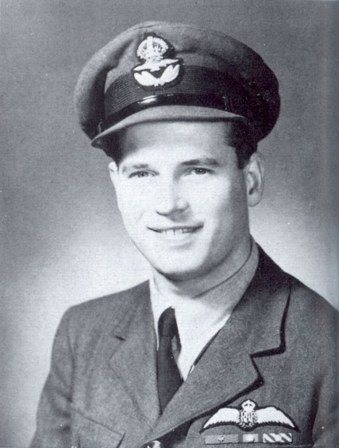|
134 (Bedford) Sqn Air Cadets |

|
| < 11th May 2005 - Rotary Jointery | 21st May 2005 - Open Day 2005 > |
Press Release |
134 (Bedford) Squadron |
17th May 2005
62 Years on, Dambusters Raid Remembered
On the 16th May 1943, nineteen specially converted Lancaster bombers from 617 Squadron took off from RAF Scampton in Lincolnshire to attack the great dams of Western Germany. 62 years on to the day, cadets from 134 (Bedford) Sqn took part in an interactive event to learn about the famous raid.

The event started the minute the members of the squadron arrived when they were met at the squadron gates by a guard wearing a genuine WW2 tin hat and made to produce their passes as the squadron had been transformed into RAF Scampton. Civilian instructor; Mr Cirin introduced the evening once everyone had assembled by giving a short introductory talk about the history of 617 Ssn and the raid for which they were formed. As soon as Mr Cirin had finished the cadets made their way outside and were transported back in time to the ship testing tanks at Teddington where they met Barnes Wallis, the aircraft designer who conceived and developed the special bouncing bomb for the mission. In reality Barnes Wallis was AWO Browne and the testing tanks were a couple of paddling pools in front of a mock dam. However the scenario enabled the cadets to understand how Barnes Wallis used a catapult built by AWO Browne, to ‘shoot’ golf balls across the surface of the water, which after many months of testing resulted in a formula for achieving exact targeting time and time again, something that was almost unheard of at the time. The cadets were able to have a go for themselves at experimenting with the catapult and managed to achieve two successful ‘hits’.

One week earlier everyone had been tasked with researching the bomb aiming device used in the Lancaster’s by the bomb aimers especially for the raid, and then to make one of his or her own. This was set as a mini competition for the most accurate representation of the real thing. With all designs presented Mr Cirin was set the task of judging the winner.
|
|
Once back inside everyone was issued with a piece of paper on which they had the name of a real aircrew member from the raid, they were sorted into crews and awaited their briefing from their commanding officer, Wing Commander Guy Gibson who was played by Cpl
Otulakowski for the event. Using the script from the film that tells the story, Wg Cdr Gibson briefed his squadron before handing back to Barnes Wallis who gave a full description of how the weapon would work. Following the briefing the aircrew all stood up one at a time and introduced themselves, they gave their rank, name and job for the mission. At this point the staff were able to explain what each job entailed and where they sat within the Lancaster. |
One at a time each crew was called and they arranged themselves as if they were in the aircraft, once ready they recreated their crews’ fate by completing their sortie, or a circuit of the building. Upon their return they were sorted with two crews being directed into a separate room, the remainder returned to the briefing room. With the returning crews settled they realised that some of their squadron colleges and friends were missing. This sobering moment was a stark realisation for many of the cadets and suddenly the reality of the loss suffered not only by 617 Sqn but also by many other RAF units during the Second World War began to take effect.
While the surviving crews tucked into their Dambuster breakfast of bacon and eggs(cooked especially for them by the Civilian Committee) the non-returning crews were informed of their own personal fate, of which all but two perished. The two who survived became prisoners of war in the Stallag Luft III camp.
The evening was rounded off when AWO Taylor, AWO Browne and Mr Cirin reassembled the cadets once again as a full squadon for the mission de-brief. The short presentation included aerial reconnaissance photos of the real dams showing the devastation caused as well as all the various honours handed out to the members of 617 Sqn.
Afterwards AWO Browne commented;
“This type of interactive event really helps the cadets to understand and relate to the rich history which makes up the Royal Air Force. We understand that most of our cadets have already sat in a classroom for 5 hours during the day and that this kind of lesson offers an alternative way of learning. While the cadets enjoy this practical and fun way of learning we also know and take time to remember the reality behind these occasions. This is the second history themed parade night that we have run in recent times and they have both proved very popular, I hope that the cadets will continue to learn more about our history with similar functions in the
future."
